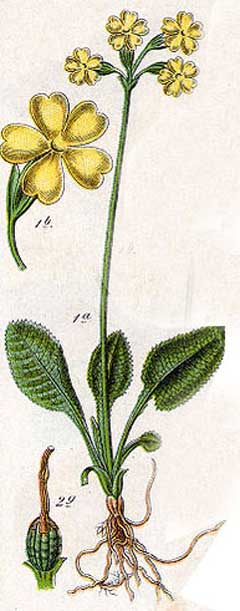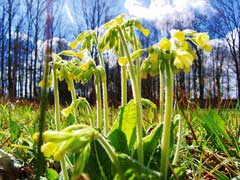 |
|
http://commons.wikimedia.org/wiki/File:Primula_spp_Sturm62.jpg |
 |
| http://commons.wikimedia.org/wiki/User:XN |
Translate this page:
Summary
Physical Characteristics

 Primula elatior is a PERENNIAL growing to 0.3 m (1ft) by 0.2 m (0ft 8in).
Primula elatior is a PERENNIAL growing to 0.3 m (1ft) by 0.2 m (0ft 8in).
See above for USDA hardiness. It is hardy to UK zone 3 and is not frost tender. It is in flower from April to May, and the seeds ripen from July to August. The species is hermaphrodite (has both male and female organs) and is pollinated by Bees, Lepidoptera (Moths & Butterflies). The plant is self-fertile.
Suitable for: medium (loamy) and heavy (clay) soils and can grow in heavy clay soil. Suitable pH: mildly acid, neutral and basic (mildly alkaline) soils and can grow in very alkaline soils.
It can grow in full shade (deep woodland) or semi-shade (light woodland). It prefers moist soil.
UK Hardiness Map
US Hardiness Map
Synonyms
Plant Habitats
Woodland Garden Dappled Shade; Shady Edge; not Deep Shade;
Edible Uses
Edible Parts: Leaves
Edible Uses:
Young leaves - raw or cooked in soups etc[13]. They have a mild flavour and are available in late winter[K].
References More on Edible Uses
Medicinal Uses
Plants For A Future can not take any responsibility for any adverse effects from the use of plants. Always seek advice from a professional before using a plant medicinally.
Diuretic Expectorant Miscellany
The root is diuretic and expectorant[9, 13]. It is used in the treatment of coughs, flu and other febrile conditions, insomnia and migraine[9, 13]. The root can be harvested in the spring or autumn and is dried for later use[9].
References More on Medicinal Uses
The Bookshop: Edible Plant Books
Our Latest books on Perennial Plants For Food Forests and Permaculture Gardens in paperback or digital formats.

Edible Tropical Plants
Food Forest Plants for Hotter Conditions: 250+ Plants For Tropical Food Forests & Permaculture Gardens.
More

Edible Temperate Plants
Plants for Your Food Forest: 500 Plants for Temperate Food Forests & Permaculture Gardens.
More

More Books
PFAF have eight books available in paperback and digital formats. Browse the shop for more information.
Shop Now
Other Uses
References More on Other Uses
Cultivation details
Prefers a medium to heavy moisture retentive humus rich loam in a cool position with light to medium shade[200], though it succeeds in heavier shade[187]. Grows well in heavy clay soils and in chalky soils[187]. A very ornamental plant[1], there are a number of subspecies[187]. The subspecies P. elatior meyeri is a parent of the P. x pruhonicensis group of ornamental hybrids[187]. This species hybridizes readily with P. vulgaris[17].
References Carbon Farming Information and Carbon Sequestration Information
Temperature Converter
Type a value in the Celsius field to convert the value to Fahrenheit:
Fahrenheit:
The PFAF Bookshop
Plants For A Future have a number of books available in paperback and digital form. Book titles include Edible Plants, Edible Perennials, Edible Trees,Edible Shrubs, Woodland Gardening, and Temperate Food Forest Plants. Our new book is Food Forest Plants For Hotter Conditions (Tropical and Sub-Tropical).
Shop Now
Plant Propagation
Seed - best sown as soon as it is ripe in a cold frame[133]. Sow stored seed in early spring in a cold frame[1]. Germination is inhibited by temperatures above 20°c[200]. Prick out the seedlings into individual pots when large enough to handle and plant out in the summer. Division in autumn. This is best done every other year[200].
Other Names
If available other names are mentioned here
Native Range
TEMPERATE ASIA: Iran (north), Turkey (east), Armenia, Azerbaijan, Georgia, Russian Federation (Altay) EUROPE: Denmark, United Kingdom (England (east)), Sweden (south), Austria, Belgium, Switzerland, Czech Republic, Germany, Hungary, Netherlands, Poland, Slovakia, Russian Federation (European part), Estonia, Lithuania, Ukraine (incl. Krym), Albania, Bulgaria, Croatia, Italy, North Macedonia, Romania, Serbia, Slovenia, Spain, France
Weed Potential
Right plant wrong place. We are currently updating this section.
Please note that a plant may be invasive in one area but may not in your area so it's worth checking.
Conservation Status
IUCN Red List of Threatened Plants Status :

| Related Plants
|
| Latin Name | Common Name | Habit | Height | Hardiness | Growth | Soil | Shade | Moisture | Edible | Medicinal | Other |
| Anagallis arvensis | Scarlet Pimpernel | Annual | 0.1 |
6-9
| | LMH | N | DM | 2 | 2 | 3 |
| Androsace sarmentosa | Rock Jasmine | Perennial | 0.1 |
3-7
| | LM | SN | DM | 0 | 2 | 3 |
| Ardisia crenata | Coralberry, Hen's eyes, Spiceberry | Shrub | 2.0 |
7-10
| S | LMH | S | M | 0 | 1 | 1 |
| Ardisia crispa | | Shrub | 1.2 |
6-9
| | LMH | S | M | 1 | 1 | 0 |
| Ardisia japonica | Marlberry | Shrub | 0.5 |
8-10
| M | LMH | S | M | 0 | 3 | 2 |
| Ardisia sieboldii | Duo Zhi Zi Jin Niu | Shrub | 6.0 |
0-0
| | LMH | S | M | 1 | 0 | 0 |
| Cyclamen hederifolium | Cyclamen, Alpine Violet, Persian Violet | Perennial | 0.1 |
6-9
| M | LM | FSN | M | 0 | 1 | 3 |
| Dodecatheon hendersonii | Sailor-Caps, Mosquito bills | Perennial | 0.3 |
5-9
| | LMH | FS | M | 1 | 0 | |
| Embelia ribes | False black pepper, White-flowered Embelia | Climber | 15.0 |
10-12
| F | LMH | S | M | 3 | 4 | 2 |
| Glaux maritima | Black Saltwort, Sea milkwort | Perennial | 0.3 |
0-0
| | LMH | N | M | 2 | 1 | |
| Hottonia palustris | Water Violet | Perennial | 0.9 |
5-9
| F | LMH | N | Wa | 0 | 1 | |
| Lysimachia barystachys | Manchurian yellow loosestrife | Perennial | 0.6 |
4-8
| | LMH | SN | M | 1 | 0 | |
| Lysimachia christiniae | Jin Qian Cao | Perennial | 0.3 |
-
| | LMH | SN | M | 0 | 2 | |
| Lysimachia clethroides | Gooseneck Loosestrife, Gooseneck yellow loosestrife, Japanese Loosestrife, Shepherd's Crook | Perennial | 1.0 |
3-8
| F | LMH | SN | M | 1 | 0 | |
| Lysimachia eleutheroides | | Perennial | 0.0 |
-
| | LMH | SN | M | 3 | 0 | |
| Lysimachia foenum-graecum | Ling Xiang Cao | Perennial | 0.5 |
-
| | LMH | SN | M | 0 | 1 | 1 |
| Lysimachia fortunei | | Perennial | 0.5 |
6-9
| | LMH | SN | MWeWa | 1 | 0 | |
| Lysimachia nemorum | Yellow Pimpernel | Perennial | 0.5 |
5-9
| | LMH | SN | MWe | 0 | 1 | |
| Lysimachia nummularia | Creeping Jenny, Moneywort, Creeping Charlie | Perennial | 0.2 |
4-8
| F | LMH | SN | MWeWa | 1 | 2 | 3 |
| Lysimachia paridiformis | | Perennial | 0.3 |
6-9
| | LMH | SN | MWeWa | 0 | 2 | |
| Lysimachia quadrifolia | Whorled Yellow Loosestrife | Perennial | 0.6 |
-
| | LMH | SN | M | 1 | 1 | |
| Lysimachia sikokiana | | Perennial | 0.6 |
-
| | LMH | SN | M | 0 | 1 | |
| Lysimachia vulgaris | Yellow Loosestrife, Garden yellow loosestrife | Perennial | 1.2 |
4-8
| | LMH | SN | MWeWa | 1 | 2 | 2 |
| Primula auricula | | Perennial | 0.2 |
3-7
| | LMH | S | M | 0 | 1 | 2 |
| Primula denticulata | Drumstick Primula | Perennial | 0.3 |
4-8
| | LMH | SN | MWe | 2 | 0 | 2 |
| Primula involucrata | | Perennial | 0.3 |
4-8
| | LMH | S | MWe | 0 | 2 | |
| Primula macrophylla | | Perennial | 0.3 |
5-9
| | LMH | N | M | 0 | 2 | |
| Primula parryi | Parry's primrose | Perennial | 0.3 |
4-8
| | LMH | FS | M | 0 | 0 | 1 |
| Primula reticulata | | Perennial | 0.4 |
5-9
| | LMH | SN | M | 0 | 1 | |
|
|
Growth: S = slow M = medium F = fast. Soil: L = light (sandy) M = medium H = heavy (clay). pH: A = acid N = neutral B = basic (alkaline). Shade: F = full shade S = semi-shade N = no shade. Moisture: D = dry M = Moist We = wet Wa = water.
Now available:
Food Forest Plants for Mediterranean Conditions
350+ Perennial Plants For Mediterranean and Drier Food Forests and Permaculture Gardens.
[Paperback and eBook]
This is the third in Plants For A Future's series of plant guides for food forests tailored to
specific climate zones. Following volumes on temperate and tropical ecosystems, this book focuses
on species suited to Mediterranean conditions—regions with hot, dry summers and cool, wet winters,
often facing the added challenge of climate change.
Read More
Expert comment
Author
(L.)Hill.
Botanical References
17200
Links / References
For a list of references used on this page please go here
Readers comment
© 2010, Plants For A Future. Plants For A Future is a charitable company limited by guarantee, registered in England and Wales. Charity No. 1057719, Company No. 3204567.